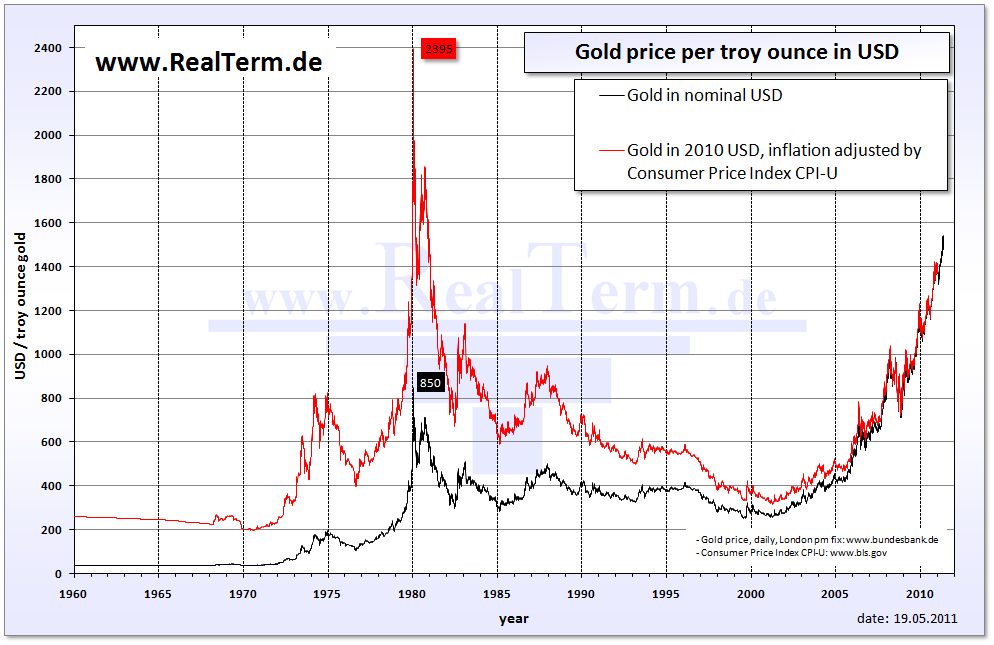Is Gold a Hedge Against Inflation
Post on: 18 Сентябрь, 2015 No Comment

In series of posts last week, I looked at Harry Browne’s Permanent Portfolio. which includes a hefty 25% allocation to gold. The reason for holding such a large amount, Browne argued, is that gold protects investors from the ravages of inflation.
The problem with this idea is that there’s no evidence that the price of gold is highly correlated with inflation—at least, not in Canada. This is one of those pieces of conventional wisdom that just doesn’t stand up to scrutiny. Gold has held its value when individual curencies have collapsed, like in Weimer Germany in the 1920s or more recently in Zimbabwe. But those are examples of catastrophic hyperinflation. which leaves people pushing around wheelbarrows of cash to buy a loaf of bread. I dont think thats what most people mean when they talk of gold as a hedge against inflation in their portfolio.
You can see how the idea developed in the 1970s. Inflation in Canada averaged almost 9% from 1970 through 1982, and gold would have provided an enormous safety net during this period: its annualized return (in Canadian dollars) was over 25% during those 13 years. The correlation was even higher in the United States and, not coincidentally, it was at the end of this period that Harry Browne introduced the Permanent Portfolio and declared gold a hedge against inflation.
Wheres the correlation gone?
Since the 1970s, however, the correlation between inflation and gold has disappeared. From 1983 through 2004, inflation averaged about 3%. Yet the nominal return on gold in Canadian dollars during this period was –0.3% annualized. That’s a real return of –50% over a period of 22 years. Not only was gold useless as an inflation hedge for more than two decades, it lost half its value along the way.
Of course, since 2005 gold has been the best performing asset class, with annualized returns of about 18% in Canadian dollars. You certainly would have done well if you had held 25% of your portfolio in gold during the last seven years—but this had nothing at all to do with inflation. Since 2005, the Consumer Price Index has gone up just 2% annually, less than the historical average.
How about on a short-term basis? If inflation spikes in a given a year, will gold act as hedge? Sure, there are examples of gold shooting up during calendar years with high inflation, such as 1974, 1980 and 1982. But there are just as many opposite moves. In 1975, inflation was almost 10% and gold lost 22%. From 1980 through 1982, inflation was over 10% annually, yet gold lost value over those three years thanks to a –33% plunge in 1981. In 1989 and 1990, inflation was well over 5%, while the return on gold was again negative in both years.
Clearly the price of gold has just about zero correlation with the Consumer Price Index .
Gold moves in mysterious ways
There is no tidy relationship between inflation and the price of gold, even in the 1970s. The tremendous returns the metal delivered during that period were the result of several factors, notably the United States abandoning the gold standard in August 1971. (Before that, the price of gold had been fixed at $35 USD per ounce since the Bretton Woods agreement of 1944.) People lost their confidence in stocks during the bear market of the early 1970s, much the way many investors feel today. This was also a time when central banks did not have the ability, the mandate, nor the political will to control inflation the way central banks do today. For example, the Bank of Canada set a target rate of 2% to 3% for inflation in 1991 and has done an extremely good job in this respect for the last 20 years.
That’s not to say that we can’t ever see a period of double-digit inflation again—of course, that remains a possibility. The point is that the cause of that inflation, and the tools we use to fight it, will be different. And therefore, if we experience double-digit inflation in the next decade, there’s no reason to expect the price of gold to behave the same way it did during the 1970s.
I don’t object to holding a small allocation of gold in a diversified portfolio, but it’s important for investors to be clear about their expectations. Gold can have periods of negative correlation with the US dollar, the world’s reserve currency. It can be a safe haven during crises of confidence in stock markets. If the global financial system collapses, if the Canadian dollar becomes worthless, or if the Harper government confiscates your land then, sure, you can exchange the bullion in your safety deposit box for canned beans and ammunition. But if you’re expecting gold to provide a hedge against inflation, then you’re likely to de disappointed.














